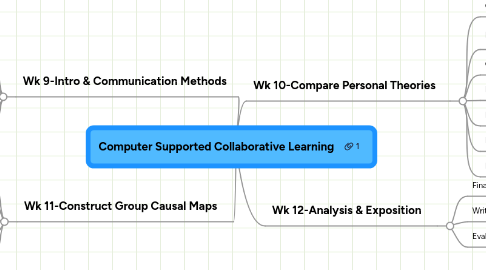
1. Wk 9-Intro & Communication Methods
1.1. Introductions
1.2. Personal Contracts
1.3. Tools/Technology for Communication
1.3.1. Chat
1.3.2. Discussion Boards
1.3.3. Telephone
1.4. Skills/procedures for Communication
1.5. Group Decision Making
1.6. Visual Models
1.7. Research Strategies
1.8. Evaluation Peer Performance
2. Wk 11-Construct Group Causal Maps
2.1. Continued Research
2.2. Continued Dialog
2.3. Construct Group Causal Map
2.4. Construct Web Site
2.5. Evaluate Peer Performance
3. Wk 10-Compare Personal Theories
3.1. Causal Maps
3.1.1. Overview
3.1.2. Creation Tools
3.1.2.1. Microsoft Exel
3.1.2.2. Gliffy.com
3.1.2.3. MindMeister
3.1.3. jMAP (Excel)
3.2. Factors that Impact Collaboration
3.2.1. Individual Factors that Influence Collaborative Learning
3.2.1.1. Individual Accountability
3.2.1.2. Learning Styles of Group Members
3.2.1.3. Learner Motivation
3.2.1.4. Internal Reflection on Group Process
3.2.2. Group Factors that Influence Collaborative Learning
3.2.2.1. United Team Spirit
3.2.2.2. Shared Vision and Goals
3.2.2.3. New node
3.2.2.4. Positive Interdependence
3.2.2.5. New node
3.2.2.6. Team Dynamism and Synergy
3.2.2.7. Quality of Communication
3.2.3. Environmental/Organizational Factors that Influence Collaborative Learning
3.2.3.1. Access to Resources
3.2.3.2. Culture of Openness
3.2.3.3. Agreed on Team Protocols
